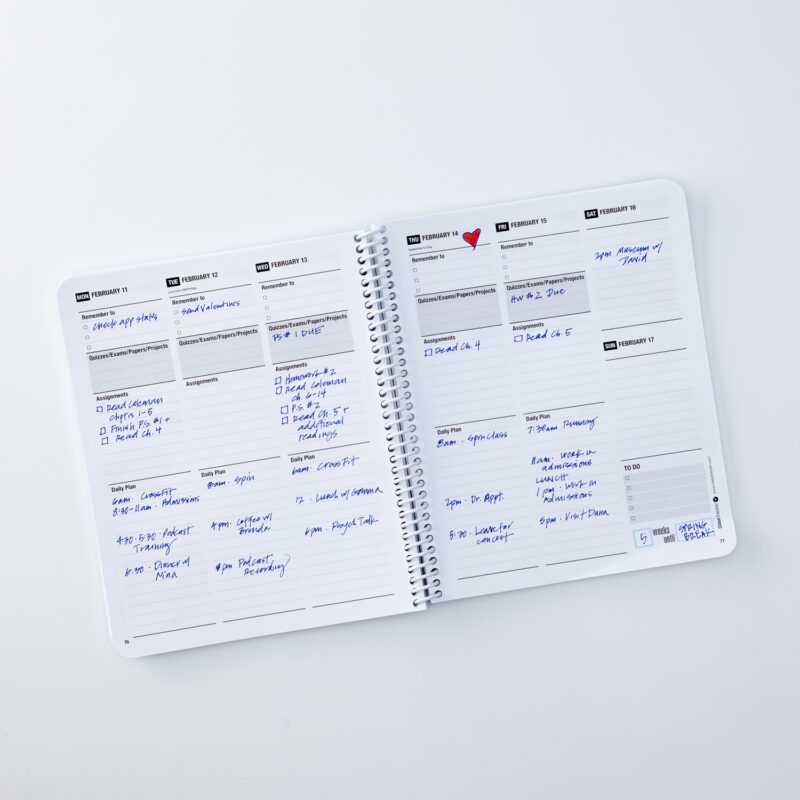A simple and organized planner or agenda with sections for your assignments, daily schedule, and activities can help keep you on track to complete your work, accomplish your goals, and succeed in all pursuits. While you might already be using a planner to map out your assignments and activities, you can also utilize your planner to construct a daily schedule and routine. Check out our tips below for building a routine (and a life!) that you love.

Reflect on your goals and values
Before you even begin to think about your tasks and your schedule, consider your goals, values, and commitments when building a daily routine that you’ll actually look forward to completing every day. Ask yourself questions such as “How do I want to spend my time every day?” and “What makes me feel happy and fulfilled?”. Make an informal list of the actions, thoughts, and behaviors that you would want to include in your ideal daily routine. Maybe your happiness comes from a favorite morning drink, moving your body every day, or chatting with your best friend. When building your daily routine in the next step, refer back to this list of joyful activities to incorporate into your every day.
Write down your daily tasks
You’re probably already doing this, but in order to build your routine, you’ll need to make a list of your tasks for the day. Whether that’s classes, homework assignments, joyful moments, or social activities, write down everything that you hope to accomplish for the day in your planner. Your task list might look a little like this:
- Biology lecture
- Yoga
- Lunch with Annie
- English seminar
- Office hours
- Improv practice
- Write English paper outline
- Movie and dinner with Katie
- Meditate for fifteen minutes
- Skincare routine
Structure your day
Depending on your tasks and your personal preferences, you will need to decide when you will complete your tasks. Given that each day is different, work on structuring your day each morning. Sit down with a cup of coffee or tea and schedule your tasks for the day. Depending on your flexibility, you may have some autonomy in when you’ll complete your tasks. If you like to be productive in the morning, be sure to get your difficult assignments done before lunch time, and then save your fun activities and social events for the afternoon and evening. Write down the time of day next to each task, along with how long you expect the task to take. For example, if yoga class runs from 8:30-9:30am, write that down next to “Yoga Class” in the daily spread on your planner. If you have a block of time in the afternoon, write “Afternoon” next to “Write English paper outline”. You might want to get more specific in the structuring of your day, which leads us to making your schedule in the next step.
Make your schedule
Structuring your day is great for when you have a fairly flexible schedule, but you may also want to schedule your day in a more specific manner. If you have a rigid schedule of classes, extracurriculars, and other engagements, it might be useful to write specific times next to your tasks. A schedule might look something like this:
- 8:00am: Wake up, shower, and get ready for the day
- 9:00am: Eat breakfast
- 9:30am: Biology lecture
- 11:00am: Yoga class
- 12:00pm: Lunch with Annie
- 1:00pm: English seminar
- 2:00pm: Office hours
- 3:00pm: Improv practice
- 5:00pm: Write English paper outline
- 6:00pm: Movie and dinner with Katie
- 8:00pm: Meditate for fifteen minutes
- 8:15pm: Skincare routine
Check in and make changes
The schedule above looks a little rigid, I know. It doesn’t leave much room for spontaneous activities or other events that might arise throughout the day. Furthermore, each day can look different, which is why it’s important to construct your daily schedule each morning. You might want to refer back to your schedule throughout the day to make changes, cross out tasks, and add new tasks. If you find that loosely planning your day works better for you, then don’t feel pressured to block out specific periods of time for each task. However, be sure to hold yourself accountable to your schedule and check off each task as you complete it. Checking tasks off will keep you motivated to work through them. Don’t forget to also include fun activities or little rewards throughout your day. Whether it’s a break for coffee with a friend or a five-minute meditation, scheduling these little self-care acts into your routine will keep you going even past the midday slump.
The first step in creating a great routine is reflecting your values and goals in your schedule. By incorporating the things that make you happy into your daily schedule, you’ll feel excited to wake up each day and tackle your schedule. Daily habits of self-care and productivity will eventually become ingrained in your routine, establishing a joyful and fulfilling life.


